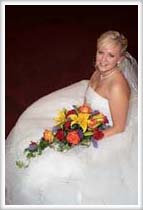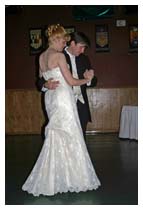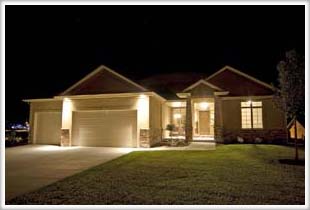PRODUCTS: Photography
Like typical HDR photography, EDR combines multiple exposures to create a better balanced image; we just take it just one step further.
Sometimes three exposures are not enough to expose your scene correctly. With EDR, we take however many exposures are necessary to make the scene balance correctly. Take these two examples.
The LDR image has a completely blown-out sky. There's no color at all in the image. The side of the building outside of the screened-in porch is also completely blown out. Now look at the milk jug in the bottom right corner. In the EDR image, detail can be seen on the sides of the jug whereas the LDR image has no definition in the corner at all.
As you can imagine, every EDR project is different. Sometimes we're able to use four images; other times we've taken up to eight to get the exposure correct.
Again, we'd love to visit with you about your special project. Please Contact Us and we'll talk about what you have in mind.
Wedding/Event Photography
The biggest difficulty we've seen in wedding or event photography is what to do with reproduction rights.
Traditional photographers give the couple an album of "proofs." The couple then picks out which images they want and select from a predetermined set of sizes. The photographer fills the order, but retains the rights to the images. The couple is then forced to return to the photographer if they ever want reprints.
In today's digital age, this seems a little old-fashioned. Digital cameras and amateur photographers are a dime a dozen; people like to "photoshop" their own pictures. Therefore, WHd has created a plan to meet this modern demand.
Our photographers show up at your event with a minimum of two people and two cameras. The senior photographer does all the normal posing and placement of people. The junior photographer wanders around with a second digital camera and takes random candid shots that catch people by surprise.
We then go through the images taken by both professionals and delete the unusable photos of the floor and our thumbs. Everything remaining gets a general color correction and sharpening. We then take the "best" shots and create the more traditional wedding package, making sure photos of the couple and family, the attendants walking down the isle and the cake cutting (if we're requested to be at the reception) appear in a professional and finished form.
Here's where it gets fun: we deliver these prints in digital form only. This allows the client to go through the images and print out what they want in the size they want and the paper type they want. They choose which pose to email the grandparents and the strange uncle who couldn't attend.
If a couple requests it, we will be happy to assist with professional printing, but the idea is to give the couple control of their pictures.
WHd retains the right to use the photographs for promotional purposes, but otherwise grants the client free use of the images.
The same idea works for any event. School plays, family reunions, anniversary celebrations, just to name a few fit our digital concept quite well.
Costs for our wedding or event photography vary depending on location and estimated time necessary on-site. Unfortunately, we have to quote these individually and dates do fill up quickly. We've charged as little as $1200 and as much as $4400. Just Contact Us for more information and for a greater supply of samples.
Traditional photographers give the couple an album of "proofs." The couple then picks out which images they want and select from a predetermined set of sizes. The photographer fills the order, but retains the rights to the images. The couple is then forced to return to the photographer if they ever want reprints.
In today's digital age, this seems a little old-fashioned. Digital cameras and amateur photographers are a dime a dozen; people like to "photoshop" their own pictures. Therefore, WHd has created a plan to meet this modern demand.
Our photographers show up at your event with a minimum of two people and two cameras. The senior photographer does all the normal posing and placement of people. The junior photographer wanders around with a second digital camera and takes random candid shots that catch people by surprise.
We then go through the images taken by both professionals and delete the unusable photos of the floor and our thumbs. Everything remaining gets a general color correction and sharpening. We then take the "best" shots and create the more traditional wedding package, making sure photos of the couple and family, the attendants walking down the isle and the cake cutting (if we're requested to be at the reception) appear in a professional and finished form.
Here's where it gets fun: we deliver these prints in digital form only. This allows the client to go through the images and print out what they want in the size they want and the paper type they want. They choose which pose to email the grandparents and the strange uncle who couldn't attend.
If a couple requests it, we will be happy to assist with professional printing, but the idea is to give the couple control of their pictures.
WHd retains the right to use the photographs for promotional purposes, but otherwise grants the client free use of the images.
The same idea works for any event. School plays, family reunions, anniversary celebrations, just to name a few fit our digital concept quite well.
Costs for our wedding or event photography vary depending on location and estimated time necessary on-site. Unfortunately, we have to quote these individually and dates do fill up quickly. We've charged as little as $1200 and as much as $4400. Just Contact Us for more information and for a greater supply of samples.
Photomontage/Panoramic Photography
Ever seen those large, wide pictures that hang in artist's shops and go across the fold in magazines? Photomontage and panoramic photography generally are the most useful ways of creating images like that.
Similar to the style and function of the VRs we do, panoramic photography takes a portion of the pictures around in a circle to create the montage. Take this example. Sixteen separate pictures were used to create this mountain view. We combined them with our software and cropped them to hide the rough edges. This panoramic photograph was done handheld outside of Vail, Colorado at the top of a mountain peak.
Many of our clients use photography like this. Combined with HDR or SHDR (see below), this type of photography is grand and reaching. Have a homestead farm you need to sell? How about advertisement for a reception hall? Want a detailed photograph for an automobile advertisement? Have a mural on a wall that needs to be in a magazine? WHd has the equipment to do it all.
Costs for this type of photography vary greatly as well. We bid these projects as they come in. Contact Us for a quote and to discuss your particular needs.
Ever seen those large, wide pictures that hang in artist's shops and go across the fold in magazines? Photomontage and panoramic photography generally are the most useful ways of creating images like that.
Similar to the style and function of the VRs we do, panoramic photography takes a portion of the pictures around in a circle to create the montage. Take this example. Sixteen separate pictures were used to create this mountain view. We combined them with our software and cropped them to hide the rough edges. This panoramic photograph was done handheld outside of Vail, Colorado at the top of a mountain peak.
Many of our clients use photography like this. Combined with HDR or SHDR (see below), this type of photography is grand and reaching. Have a homestead farm you need to sell? How about advertisement for a reception hall? Want a detailed photograph for an automobile advertisement? Have a mural on a wall that needs to be in a magazine? WHd has the equipment to do it all.
Costs for this type of photography vary greatly as well. We bid these projects as they come in. Contact Us for a quote and to discuss your particular needs.
High Dynamic Range (HDR) Photography
The standard of WHd photography, HDR photography is the most versatile and most widely used by all of our clients.
Most digital cameras available in today's market have a built-in feature which allows the photographer to take multiple exposures in quick succession. Three is the typical max. For the most part, any shots done by WHd that do not involve moving people or objects are shot using HDR by default. This allows us more latitude in correcting exposure issues and gives the picture a deeper range of color.
The three exposures are processed by the computer into one image containing the dynamic range of all three photographs. Take the example on the right. One exposure correctly exposing the scene would leave HUGE bright spots under all the lights and in all the windows. The top of the gable on the house would also be invisible in shadow. By combining a second shorter exposure, the light spots are manageable and one can even see inside the windows. Adding a third exposure to the scene, we brighten up the dark roof edge and allow the roof to be defined in the shot. This photograph couldn't be taken with traditional photography.
Specialist shoots like these take an extreme amount of planning and timing. Every project is a little bit different. We have a minimum fee charge, usually $200, which can be applied to products ordered. Normally customers combine the HDR photography with our VRs into a package deal, getting both still images and VRs of the same location.
If you have a special circumstance, Contact Us. We'd be happy to talk with you and discuss different techniques to photograph your subject properly.
Most digital cameras available in today's market have a built-in feature which allows the photographer to take multiple exposures in quick succession. Three is the typical max. For the most part, any shots done by WHd that do not involve moving people or objects are shot using HDR by default. This allows us more latitude in correcting exposure issues and gives the picture a deeper range of color.
The three exposures are processed by the computer into one image containing the dynamic range of all three photographs. Take the example on the right. One exposure correctly exposing the scene would leave HUGE bright spots under all the lights and in all the windows. The top of the gable on the house would also be invisible in shadow. By combining a second shorter exposure, the light spots are manageable and one can even see inside the windows. Adding a third exposure to the scene, we brighten up the dark roof edge and allow the roof to be defined in the shot. This photograph couldn't be taken with traditional photography.
Specialist shoots like these take an extreme amount of planning and timing. Every project is a little bit different. We have a minimum fee charge, usually $200, which can be applied to products ordered. Normally customers combine the HDR photography with our VRs into a package deal, getting both still images and VRs of the same location.
If you have a special circumstance, Contact Us. We'd be happy to talk with you and discuss different techniques to photograph your subject properly.
Expanded Dynamic Range (EDR) Photography
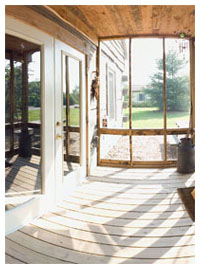 LDR Photo |
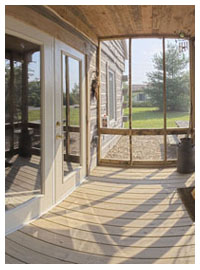 EDR Photo |
Sometimes three exposures are not enough to expose your scene correctly. With EDR, we take however many exposures are necessary to make the scene balance correctly. Take these two examples.
The LDR image has a completely blown-out sky. There's no color at all in the image. The side of the building outside of the screened-in porch is also completely blown out. Now look at the milk jug in the bottom right corner. In the EDR image, detail can be seen on the sides of the jug whereas the LDR image has no definition in the corner at all.
As you can imagine, every EDR project is different. Sometimes we're able to use four images; other times we've taken up to eight to get the exposure correct.
Again, we'd love to visit with you about your special project. Please Contact Us and we'll talk about what you have in mind.



